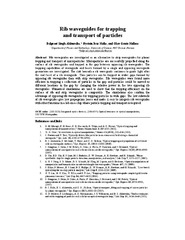| dc.contributor.advisor | Hellesø, Olav Gaute | |
| dc.contributor.author | Løvhaugen, Pål | |
| dc.date.accessioned | 2013-05-15T12:54:22Z | |
| dc.date.available | 2013-05-15T12:54:22Z | |
| dc.date.issued | 2012-12-21 | |
| dc.description.abstract | Optical waveguides are used to confine propagating light. In a dielectric waveguide, a small part of the propagating light travels along and just outside the waveguide surface. This evanescent field can interact with objects on the waveguide surface. Two effects of this light-matter interaction are presented, optical forces and Raman scattering.
Optical forces are caused by changes in the momentum of radiation. The forces are exerted on objects interacting with a propagating field. The magnitude of the force is dependent on the difference in permittivity and permeability between the object and the surrounding medium. The forces can be used to trap and control micro- and nanoparticles.
In Raman scattering, the scattered field exchanges energy with the scatterer. The amount of energy that is lost or gained depends on the molecular structure of the scatterer. By collecting the spectra of the scattered light, the molecules in the scatterer can be analyzed and characterized.
Two numerical studies have been performed to simulate optical forces on a range of micrometer-sized objects trapped and propelled on a waveguide. A numerical model of a hollow glass sphere provides new insights on how the optical force depends on the glass thickness. A numerical model of a red blood cell studies the force dependence on cell shape and refractive index. A model of a real-sized cell is made.
Two experimental studies have used Raman spectroscopy to characterize and analyze objects subject to optical forces. One study looks at the viability of using Raman scattering to characterize objects trapped on waveguides. It was found that characterization with Raman spectroscopy is viable with the use of an external, focused light source, while excitation using the evanescent field is difficult. A second study investigates a new technique for proliferation measurements of non-adherent cells. A combined optical trapping–Raman spectroscopy setup is used to show that a Raman probe can be used to measure proliferation of actively replicating cells, even in a sample were the cell growth is slow or negative.
The presented studies were performed to investigate the potential of combining characterization with optical trapping on waveguides. This could be of use in an optical lab-on-a-chip for cells. | en |
| dc.description.doctoraltype | ph.d. | en |
| dc.description.popularabstract | Utvikling av mikro-laboratorier på databrikker (“lab-on-a-chip”) vil muliggjøre raske kjemiske og biokjemiske analyser på stedet. Optiske bølgeledere vil kunne bidra til transport av mikropartikler og celler på slike brikker. Oppgaven presenterer numeriske og eksperimentelle resultater av betydning for denne utviklingen.
Numeriske analyser er gjort for å undersøke egenskapene til forskjellige mikropartikler og celler transportert på en bølgeleder. Det blir vist at endringer i form, størrelse og brytningsindeks påvirker hastigheten til partiklene. Resultatene blir sammenlignet med eksperimentelle hastigheter.
Et mikroskop for Raman-spektroskopi har blitt konstruert. Dette er brukt til karakterisering av mikropartikler som transporteres på en bølgeleder. Et annet mikroskop har blitt brukt til å måle celleformering med Ramanspektroskopi. Målemetoden brukes for første gang på ikke-heftende celler, og viser at det kan la seg gjøre å utføre analyser av blodceller på en bølgeleder. | en |
| dc.description.sponsorship | The Research Council of Norway, project 177956, Optical Functions And Lab-on-a-chip For Microparticles And Biomedicine | en |
| dc.identifier.isbn | 978-82-8236-076-0 | |
| dc.identifier.isbn | 978-82-8236-077-7 | |
| dc.identifier.uri | https://hdl.handle.net/10037/5151 | |
| dc.identifier.urn | URN:NBN:no-uit_munin_4864 | |
| dc.language.iso | eng | en |
| dc.publisher | Universitetet i Tromsø | en |
| dc.publisher | University of Tromsø | en |
| dc.rights.accessRights | openAccess | |
| dc.rights.holder | Copyright 2012 The Author(s) | |
| dc.rights.uri | https://creativecommons.org/licenses/by-nc-sa/3.0 | en_US |
| dc.rights | Attribution-NonCommercial-ShareAlike 3.0 Unported (CC BY-NC-SA 3.0) | en_US |
| dc.subject | VDP::Mathematics and natural science: 400::Physics: 430::Electromagnetism, acoustics, optics: 434 | en |
| dc.subject | Optical waveguides | en |
| dc.subject | Optical forces | en |
| dc.subject | Optical trapping | en |
| dc.subject | Waveguide trapping | en |
| dc.subject | Waveguide simulation | en |
| dc.subject | Optical force simulation | en |
| dc.subject | Low-index trapping | en |
| dc.subject | Red blood cell trapping | en |
| dc.subject | Lab-on-a-chip | en |
| dc.subject | VDP::Mathematics and natural science: 400::Chemistry: 440::Physical chemistry: 443 | en |
| dc.subject | Raman spectroscopy | en |
| dc.subject | VDP::Mathematics and natural science: 400::Basic biosciences: 470::Cell biology: 471 | en |
| dc.subject | Cell proliferation assay | en |
| dc.title | Optical Forces, Waveguides and Micro Raman Spectroscopy | en |
| dc.type | Doctoral thesis | en |
| dc.type | Doktorgradsavhandling | en |


 English
English norsk
norsk



